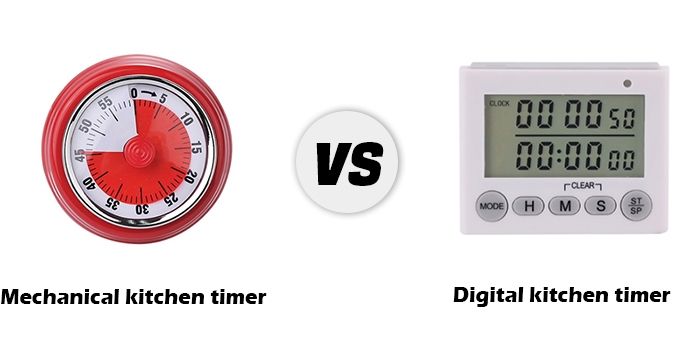In any kitchen, timing is everything. Whether you're baking a cake, simmering a sauce, or boiling pasta, having a reliable kitchen timer can mean the difference between culinary success and disappointment. Kitchen cooking timers come in a variety of types, but the two most common are mechanical and digital. Though they serve the same purpose, they differ in various aspects.
This article explores the key differences between mechanical and digital kitchen timers, helping you understand their unique advantages and limitations so you can choose the kitchen food timer best suited to your cooking style.

Design and Appearance
One of the most noticeable differences between mechanical and digital kitchen timers is their design. Mechanical kitchen timers typically have a retro or classic look. They often come in round, egg-shaped, or animal-shaped. To use them, you turn a dial to set the desired time. The internal mechanism consists of a spring that winds up and then unwinds slowly to count down the time. The design is entirely manual, simple, and self-contained. Their analog nature gives them a nostalgic charm and simplicity that appeals to many traditionalists and lovers of vintage aesthetics.
On the other hand, digital food timers have a more modern and sleek appearance. They feature an LCD or LED display and are operated using buttons rather than dials. The screen shows the exact time set, usually down to the second. Digital timers often have extra features such as backlighting, multiple timers, and touch-sensitive controls, which can enhance the cooking experience in high-tech kitchens.
Working Principle
A mechanical countdown timer operates purely on physical mechanisms without the need for electricity or batteries. Its core working principle relies on a wound spring and a gear system. When you turn the dial to set the desired time, you are winding up a mainspring inside the timer. This wound spring stores potential energy. As the timer operates, the spring gradually unwinds, releasing energy at a controlled rate through a series of gears and an escapement mechanism.
The escapement controls the unwinding speed, ensuring that the timer counts down accurately. Once the spring unwinds completely to the zero point, it triggers a mechanical bell or alarm to alert the user. The entire process is powered by the energy stored in the spring and regulated by the mechanical parts. Mechanical timers are known for their durability and simplicity. However, they usually have a maximum time limit (often 60 minutes)
A digital timer operates based on an electronic timing circuit, typically controlled by a microcontroller. When a user sets a time using buttons, the microcontroller stores the countdown value in its memory. Once started, the timer uses an internal clock to count seconds accurately. It continuously subtracts time from the preset value, updating the display, usually an LED or LCD screen, in real-time. When the countdown reaches zero, the timer activates an alarm circuit to produce a beeping sound, alerting the user. The design ensures accurate timing, ease of use, and low power consumption. Some advanced timers also include multiple countdowns, forward timing function, memory for frequently used times, or even touch controls. Overall, the digital kitchen timer combines simple user input with precise internal electronics for reliable performance.
Accuracy
Mechanical food timers are generally less precise. Since they rely on physical mechanisms, small errors in manufacturing or wear and tear over time can affect their accuracy. First, the spring and gears can wear out over time, affecting how smoothly they unwind. Even small defects in the gears can lead to timing inaccuracies. Also, mechanical timers are typically imprecise when set for very short durations (under five minutes) because it's harder to turn the dial accurately to such small time intervals. Users might accidentally overshoot or undershoot the desired time. Environmental factors like humidity and temperature can also affect the internal mechanics, further reducing accuracy.
Digital timers are typically highly accurate. Since they rely on electronic circuits to track time, there's much less variability. They are perfect for recipes that require exact timing, such as brewing tea, baking macarons, or cooking delicate sauces. Most digital cooking timers also allow settings down to the second, which is particularly useful for tasks like timing espresso shots or boiling soft eggs. Digital timers allow users to input exact times, down to the second if needed. There's no guessing or estimating based on a dial's position. Whether you need 3 minutes and 25 seconds or 45 minutes exactly, a digital timer can be set precisely. Moreover, digital timers remain consistent over time; they do not wear down mechanically in a way that would affect their accuracy. Battery life can slightly impact performance if the battery is nearly dead, but even then, most digital timers tend to slow down or turn off rather than continue running inaccurately. Nowadays, some digital timers can also be charged, making them more convenient for users.
Environmental Impact
Mechanical timers are arguably more environmentally friendly because they don't require batteries or electricity. They generate no electronic waste and can last for many years without replacement, reducing their environmental footprint. Digital timers require batteries, which need to be replaced and properly disposed of. While their power consumption is low, the cumulative environmental impact of battery production and disposal can be significant if not managed responsibly.
Conclusion
Both mechanical and digital kitchen timers have their place in the kitchen, and each brings its unique strengths to the table. Mechanical timers charm with their simplicity, tactile nature, and reliability. Digital timers, on the other hand, shine with their precision, versatility, and modern features. Both types of timers are provided on SISCO. The best timer for you depends on your personal cooking style, aesthetic preferences, and functional needs.

